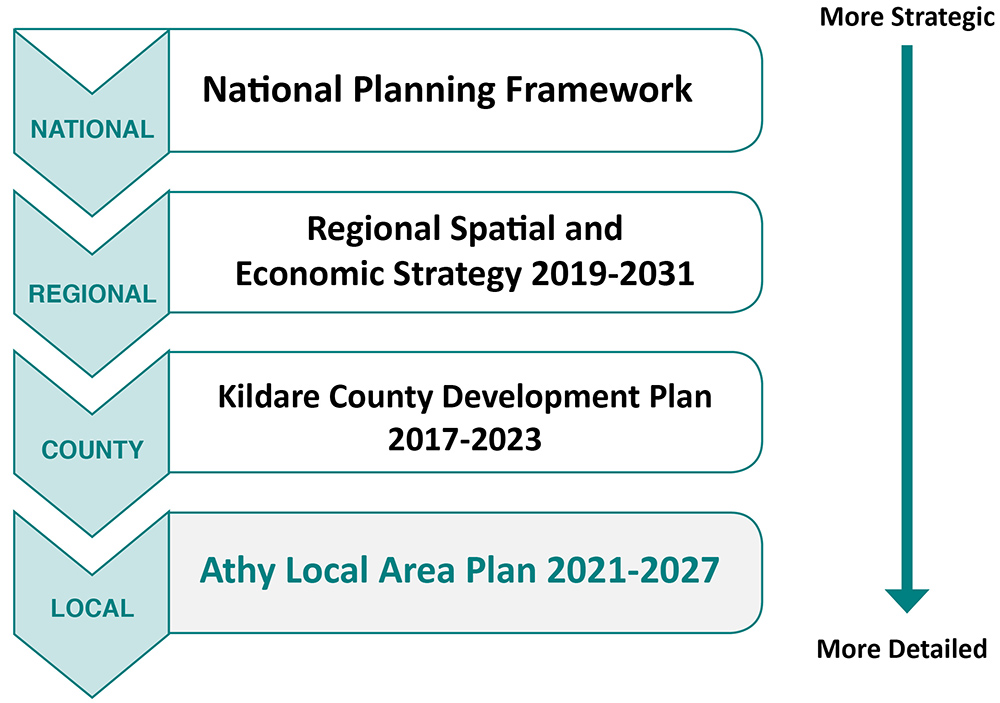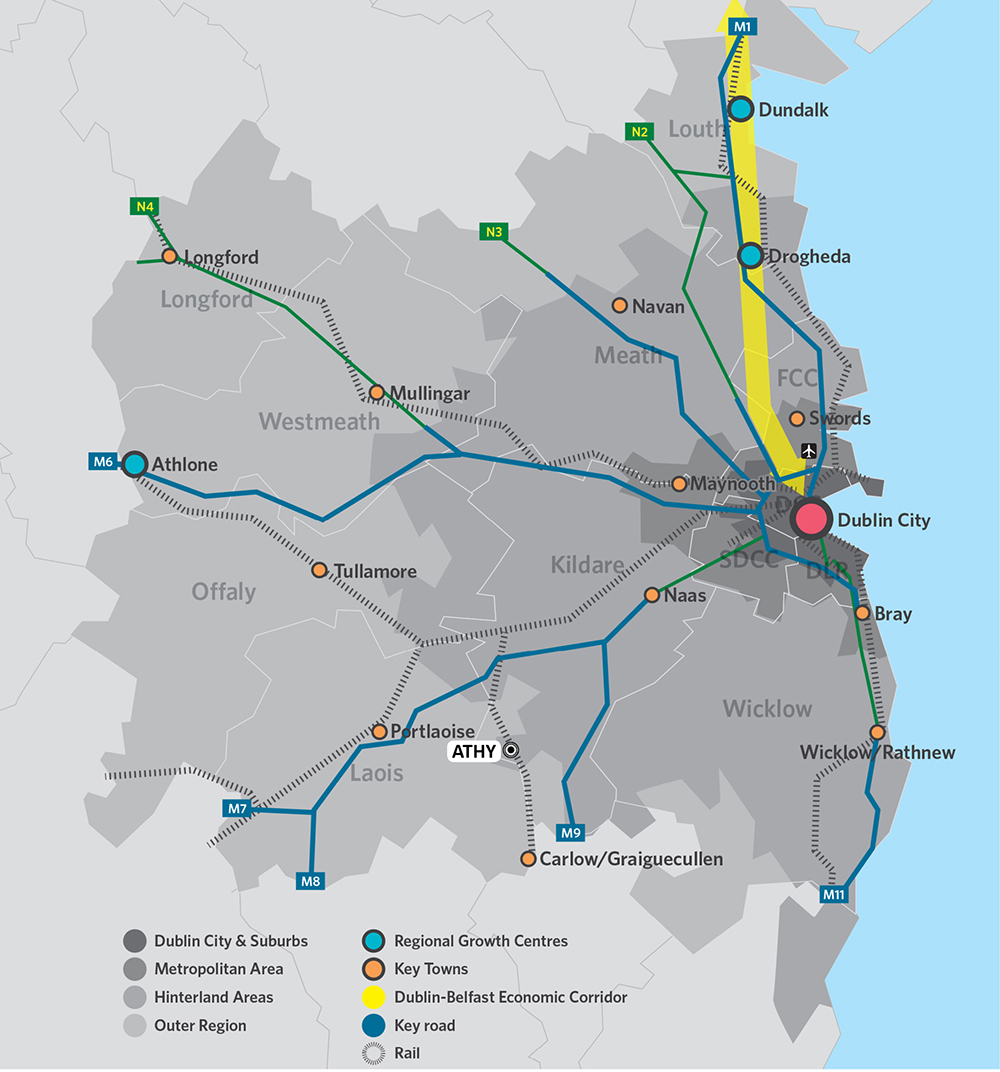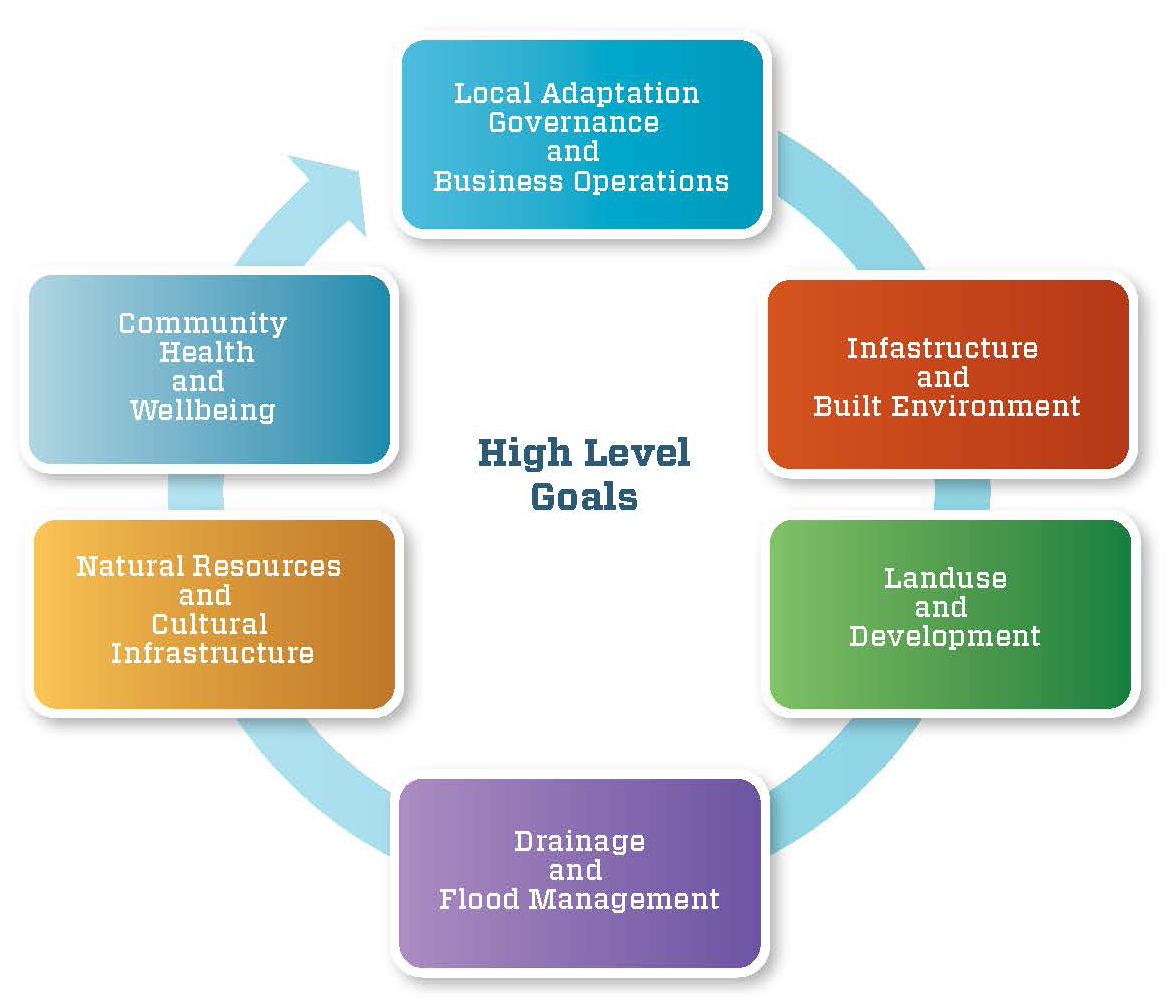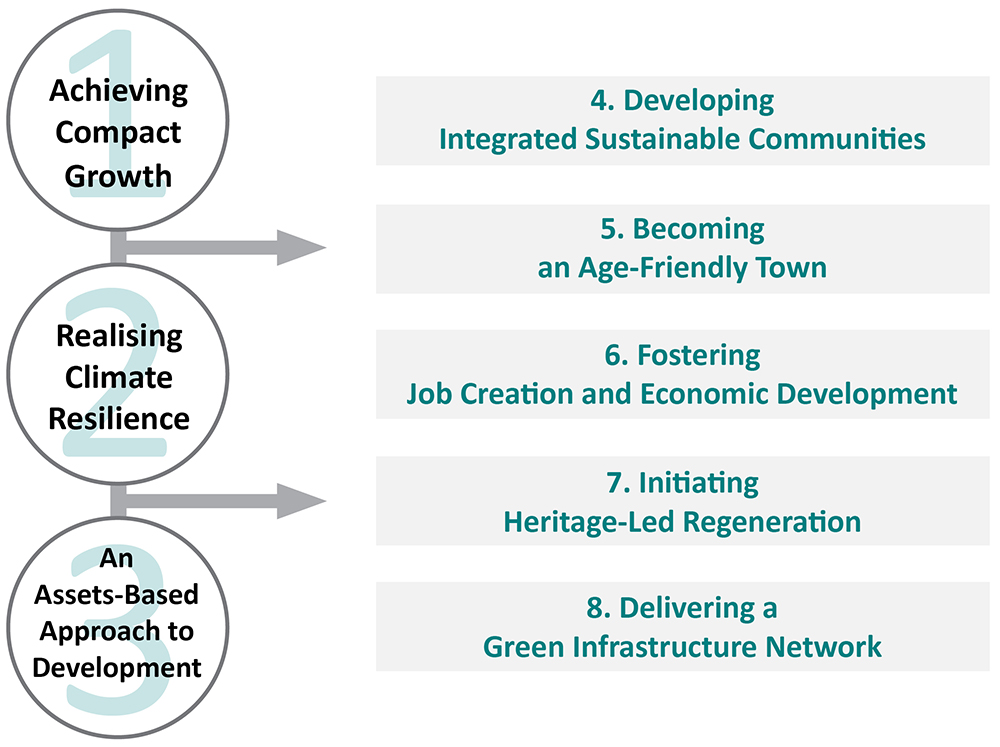02. Spatial Planning Context & Vision for Athy
Aim: To set out the statutory context of the Athy Local Area Plan in relation to its position within the hierarchy of spatial plans and outline an ambitious and achievable vision for the sustainable development of the town in the period to 2027 and beyond.
2.1 Compliance with the Hierarchy of Plans
In establishing a framework for the sustainable planning and development of Athy in the period to 2027 and beyond, it is important that the position of the Athy Local Area Plan within the overarching spatial planning hierarchy be outlined in order to provide a level of context but also to demonstrate how the plan complies with these overarching policy documents, in line with statutory requirements. The provisions of these plans and strategies, insofar as they relate to the planning and development of Athy, are also crucial and will be discussed below.
Figure 2.1: Hierarchy of Spatial Plans

2.1.1 National Planning Framework
The National Planning Framework (NPF) together with the National Development Plan (2018-2027) was published in 2018 under Project Ireland 2040. Project Ireland 2040 is the Government’s overarching long-term policy platform to guide and manage the future growth and development of the country. The primary aim of Project Ireland 2040 is to improve the quality of life in Ireland for all its citizens by creating and promoting opportunities for people and protecting and enhancing our environment. In order to achieve this goal, the NPF contains a series of national policy objectives (NPOs), which set out the intentions of the plan within specific areas. Table 2.1 (see overleaf) outlines the NPOs which are most relevant to the preparation of the Athy Local Area Plan.
Table 2.1: List of National Policy Objectives which relate to the Draft Athy Local Area 2021-2027
| National Policy Objective (NPO) | Plan Response |
|
NPO 3c: Deliver at least 30% of all new homes that are targeted in settlements other than the five Cities and their suburbs, within their existing built-up footprints. |
A substantial majority of the housing target will be delivered within the existing footprint of the town. |
|
NPO 4: Ensure the creation of attractive, liveable, well- designed, high quality urban places that are home to diverse and integrated communities that enjoy a high quality of life and well-being. |
Strategy focuses on creating sustainable and integrated communities. |
|
NPO 6: Regenerate and rejuvenate cities, towns and villages of all types and scale as environmental assets, that can accommodate changing roles and functions, increased residential population and employment activity and enhanced levels of amenity and design quality, in order to sustainably influence and support their surrounding area. |
Plan will adopt an ‘asset based approach’ to development which will seek to utilise the town’s existing social, economic and environmental assets to drive the sustainable growth of the town. |
|
NPO 7: Apply a tailored approach to urban development that will be linked to the Rural/Urban Regeneration and Development Fund. |
Includes an urban regeneration framework which will identify a series of projects that can be funded under the RRDF/URDF programme. |
|
NPO 17: Enhance, integrate and protect the special physical, social, economic and cultural value of built heritage assets through appropriate and sensitive use now and for future generations. |
Conservation and heritage-led regeneration policies included in the Plan for built heritage assets. |
|
NPO 27: Ensure the integration of safe and convenient alternatives to the car into the design of our communities, by prioritising walking and cycling accessibility to both existing and proposed developments, and integrating physical activity facilities for all ages. |
The Plan promotes an age-friendly town which seeks universal accessibility and prioritises the development of sustainable modes of travel. |
|
NPO 35: Increase residential density in settlements, through a range of measures including reductions in vacancy, reuse of existing buildings, infill development schemes, area or site-based regeneration and increased building heights. |
The Plan provides for residential development at sustainable densities in accordance with Section 28 Ministerial Guidelines. |
|
NPO 53: Support the circular and bio economy including in particular through greater efficiency in land management, greater use of renewable resources and by reducing the rate of land use change from urban sprawl and new development. |
The Plan and the Urban Regeneration Framework (Appendix 1) includes targeted active land management provisions supported by a number of specific objectives. |
|
NPO 54: Reduce our carbon footprint by integrating climate action into the planning system in support of national targets for climate policy mitigation and adaptation objectives, as well as targets for greenhouse gas emissions reductions. |
Plan integrates national policies on climate action by promoting compact growth, sustainable movement and other adaption/mitigation measures. |
|
NPO 58: Integrated planning for green infrastructure and ecosystem services will be incorporated into the preparation of statutory land use plans. |
Identification of an integrated green infrastructure network to be protected and enhanced throughout the life of the Plan. |
2.1.2 Regional Spatial and Economic Strategy
The Regional Spatial and Economic Strategy (RSES) for the Eastern and Midland Region 2019-2031 sets out a framework to direct future growth of the region over the medium to long term. The Strategy is underpinned by key people-focused principles that reflect the three pillars of sustainability (Social, Environmental and Economic).
Figure 2.2: Three Key Principles of the RSES

The central purpose of the RSES is to support the implementation of the NPF and the economic policies and objectives of the Government by providing a coordinated strategic planning and economic framework for the development of Ireland’s regions. In this regard both the RSES and NPF contain provisions which are particularly relevant to the development strategy being pursued in the Local Area Plan. The first is the achievement of compact growth by building at sustainable densities, infill development and urban regeneration. The second is the pursuit of an asset-based approach to development which seeks to enhance and expand upon the existing resources of Athy be they natural, cultural, or economic. Lastly, the realisation of climate resilience within the settlement will be of critical importance in underpinning the long-term sustainable development of the town.
What is a ‘Self-Sustaining Growth Town’?
|
Self-Sustaining Growth Towns are described in the Regional Spatial and Economic Strategy as towns with ‘a moderate level of jobs and services. Such settlements include sub-county market towns and commuter towns with good transport links and capacity for continued commensurate growth to become more self-sustaining.’ |
hierarchy. Accordingly, the Kildare County Development Plan 2017-2023 (as varied) has identified Athy as a ‘Self-Sustaining Growth Town’, the highest possible category the Local Authority could assign. This designation was made on the basis of a comprehensive economic analysis of all settlements in the county. This demonstrated the critical role that Athy has as an employment and services centre not only for its resident population but also for its wider rural hinterland area.
Figure 2.3: Location of Athy within the Eastern and Midland Region

Source: Settlement Strategy of the Eastern and Midlands Region 2019 – 2031 (p. 45, RSES) as amended
It is noted that the RSES states that the policy response to settlements which local authorities define as ‘self-sustaining growth towns’ should be to promote and support the consolidation of the settlement coupled with targeted investment where required to improve local employment, services and sustainable transport options in order to become more self-sustaining (RSES, Table 4.3, Page 47).
2.2. Integrating Climate Considerations into the Athy Local Area Plan
|
What is climate mitigation and adaptation? Climate mitigation refers to measures to reduce climate change by limiting greenhouse emissions. It includes strategies to reduce activities that give rise to greenhouse gases and to enhance carbon sinks. Adaptation refers to actions which seek to better manage and reduce the risks and effects associated with existing or anticipated climate change and exploit beneficial opportunities. |
One of the cross-cutting principles of this Plan (see Section 2.3.1) is to initiate a transition to a low carbon and climate resilient society, a necessary measure that is also a National Strategic Outcome (NSO 8) of the National Planning Framework. In tackling global warming, a comprehensive legislative and policy framework relating to climate action has been developed in Ireland over the past number of years. These provisions seek to ensure that climate considerations are fully integrated into spatial plans such as the Athy Local Area Plan.
Whilst the primary long term goal is to achieve net zero emissions by 2050 (Climate Action Plan, 2019), recent policy developments reflect a widespread acceptance that climate change is happening now, and its effects will only get more disruptive to both societies and the environment. Therefore, there is increasing emphasis on plans integrating mitigation and adaptation measures. In this regard, the Kildare’s Climate Adaptation Strategy 2019-2024 has provided a critical point of reference in preparing this plan.
The publication of the first Kildare County Council Climate Adaptation Strategy (2019), as provided for under the Low Carbon Development Act 2015, signalled the beginning of a coordinated cross- departmental approach to implementing climate mitigation and adaptation measures. Accordingly, the strategy contains an adaptation framework which incorporates objectives and actions that encompass all services, functions and operations of the Council. The strategy is centred around six complementary high level goals (see Figure 2.4) with each one containing a suite of relevant actions directed by specific objectives.
Figure 2.4: Goals of the Climate Adaptation Strategy

While some objectives apply to all areas of the Council, others such as those contained in Goal 3: Land Use and Development specifically apply to the preparation of this Plan. Such objectives seek to:
- Integrate climate action considerations into land use planning policy.
- Explore policies to help the transition to a climate resilient low carbon society.
- Promote and maximise the most efficient and sustainable use of land.
It is noted that other goals contain objectives and actions relevant to this plan, including Goal 2: Infrastructure and the Built Environment (the incorporation of green infrastructure and biodiversity provision in plans) and Goal 4: Drainage and Flood Management (flooding avoidance and adaptation measures).
|
The Draft Athy Local Plan 2021-2027, through its various policies, objectives, and actions incorporates and provides for the following measures to both limit the amount of greenhouse gas emissions and increase the resilience of the town to the effects of existing and future climate change:
|
|
Policy CAM 1 – Climate Adaptation and Mitigation It is the policy of the Council to future proof Athy to ensure that it becomes a climate resilient town by promoting the economic, social and environmental benefits of low-carbon development, creating an integrated green infrastructure network, prioritising sustainable mobility within the town and building at sustainable densities in appropriate locations. Objective It is an objective of the Council to: CAMO1.1 Support the full implementation of the Kildare County Council Climate Change Adaptation Strategy 2019-2024, or any succeeding document, with regards to its goals, objectives and actions relating to the planning and development of Athy.Action
|
2.3 A Vision for Athy
The Local Area Plan is underpinned by a strategic vision which is intended to guide the future growth of Athy in a sustainable manner, in a way that reflects the inherent character of the area and identifies the potential of utilising its existing assets as the basis for improving the quality of life, wellbeing and resilience of both the present and future residents of the town.
|
Vision Statement To successfully fulfil Athy’s role as a self-sustaining growth town by embracing the transition to a low carbon and climate resilient model of development which seeks to utilise and invest in the town’s existing economic, social and environmental assets to generate sustainable economic development and job creation, thereby enhancing its status as the main economic and services centre of South Kildare. The vision for the Local Area Plan will ensure that growth planned for the town over the life of the Plan and beyond occurs in a sustainable and sequential manner, characterised by a compact, consolidated and permeable pattern of development linked by sustainable modes of transport including a robust network of pedestrian and cycle routes, providing a high level of connectivity; facilitating and enabling the creation of a healthy, safe and age-friendly community. In essence, by 2027 a series of concerted steps will have been taken to ‘future proof’ Athy and create a more sustainable inclusive settlement centred around a regenerated and vibrant town centre providing important retail and commercial services and hosting an improved tourist offer. The town will not only be more resilient to the effects of climate change but will also have adapted to the needs of a growing and aging population, through the development of integrated communities, served by an enhanced level of social infrastructure and an expanded green infrastructure network. |
2.3.1 Strategic Development Principles
The vision is underpinned by a number of strategic development principles which are designed to provide a level of focus and direction to the policies, objectives and actions within this Local Area Plan. The principles were developed on the basis of the many strengths of the town and seek to overcome the weaknesses and threats identified in order to future proof Athy and provide for its long term growth and sustainable development.
Three of the principles; Achieving Compact Growth; Realising Climate Resilience; and Pursuing an Asset-Based Approach to Development are over-arching and cross-cutting in nature, insofar as they can only be attained through the implementation of the others (see Figure 2.5, overleaf). For example, the delivery of compact growth will be dependent on developing integrated sustainable communities and a successful regeneration of the town centre. The principles can therefore be seen to be interdependent and mutually supportive i.e. the delivery of an accessible green infrastructure network both for nature conservation and recreational/tourism uses will also enable better connectivity between communities and help Athy become an age friendly and more inclusive town, delivering a better quality of life for all.
Figure 2.5: Strategic Development Principles of the Athy Plan

- Achieving Compact Growth: In keeping with stated planning policy at all levels of the spatial hierarchy, a key priority of the Plan is to develop a compact and coherent urban form with particular emphasis being placed on the regeneration of the town centre, building within the existing urban footprint of the town and providing for orderly sequential development.
- Realising Climate Resilience: The Local Area Plan endeavours to accelerate the transition to a low carbon model of development, which will better equip the town in managing the adverse impacts of climate change, whilst also providing for a better quality of life for residents of the town.
- An Asset-Based Approach to Development: This approach involves utilising and investing in the existing social, economic and natural assets of Athy. In such a way, the town’s rich stock of built and natural heritage can be harnessed and appropriately developed to provide for sustainable locally based employment opportunities. In this regard the development of the Barrow Blueway walking and cycling route along the Barrow Line Canal will be a critical project.
- Developing Integrated Sustainable Communities: Focusing on the idea of healthy placemaking, this wide-ranging principle will ensure that new residential areas are being built at sustainable densities in appropriate locations, but also seeks to create a more connected town, linking existing neighbourhoods with key destinations by sustainable and active modes of transport. This principle also involves an enhanced level of social infrastructure provision to service the needs of the residents of the town and its surrounding rural hinterland.
- Becoming an Age Friendly Town: Similar to many settlements across the country the population of Athy is aging. In order to ensure that this growing cohort of people continues to contribute and participate in the social and economic life of the town, it is necessary to put in place and where appropriate retrofit, the infrastructure needed to ensure universal accessibility.
- Fostering Jobs Creation and Economic Development: Ensure the realisation of Athy as a Self- Sustaining Growth Town by supporting existing and encouraging new enterprise and employment generating activities within the town. Such support also includes the delivery of key infrastructural projects such as the Athy Distributor Road which will improve the accessibility and the functioning of business activities in Athy.
- Initiating Heritage-Led Regeneration: Such an approach is key to ensuring the continued viability of the historic core as a centre for commercial activities. The Local Area Plan includes an Urban Regeneration Framework for Athy, which will primarily focus on how the historic centre can accommodate changing roles and functions, increase its residential population and employment activity, and provide for a transformed public realm that will enhance the user experience of shoppers, visitors and the community as a whole.
- Delivering a Green Infrastructure Network: The creation of such a network will not only protect Athy’s strategic natural assets but also enhance the town’s climate resilience, protect biodiversity within the town and be the focus of public recreational and tourism activities.